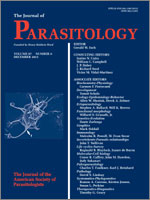Prevalence and seasonal distribution of Ctenocephalides canis (Curtis) and Ctenocephalides felis (Bouché) infestations in urban dogs of the city of Aguascalientes, Mexico, were studied. Between January and December 2007, 863 dogs in the Municipal Canine and Feline Control Center were examined. Overall prevalence of infestation was 12% (95% CI 10–14). Seasonal distribution revealed that prevalences in spring and summer were highest, while autumn and winter had lower prevalences. Two infestation peaks were observed, i.e., in April (17.7%) and July (18.9%). A positive correlation was detected between prevalence and temperature during the winter season (P < 0.05). Prevalence in relation to gender showed that males were more frequently infested, 14% (95% CI 11–17), than females, 9.4% (95% CI 7–13); hair length did not affect differences in prevalence. Six hundred twenty-nine fleas were examined; 62% were C. canis and 38% C. felis. Dogs infested with only C. canis were 48% (95% CI 38–58), while 18% were infested only with C. felis (95% CI 11–27); the remainder, 34% (95% CI 24–44), had mixed infestations.
How to translate text using browser tools
1 December 2011
Presence of Ctenocephalides canis (Curtis) and Ctenocephalides felis (Bouché) Infesting Dogs In the City of Aguascalientes, México
Emmanuel Hernández-Valdivia,
Carlos Cruz-Vázquez,
Raúl Ortiz-Martínez,
Arturo Valdivia-Flores,
Ma. Teresa Quintero-Martínez
ACCESS THE FULL ARTICLE

Journal of Parasitology
Vol. 97 • No. 6
December 2011
Vol. 97 • No. 6
December 2011




